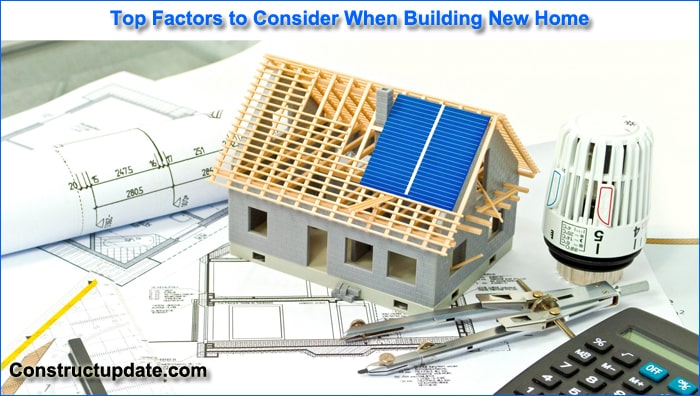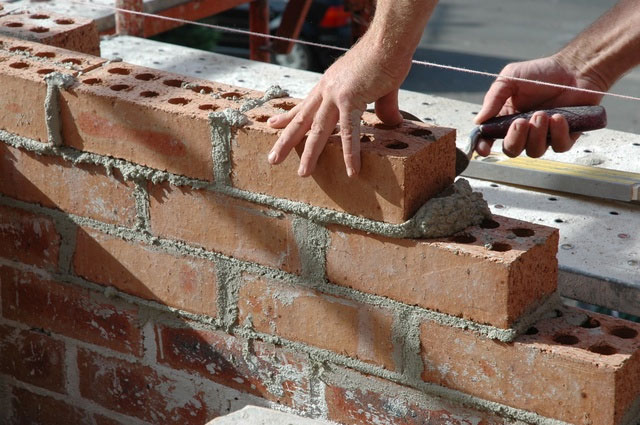10 Important Factors to Consider while Building a New Home
Everyone spends most of their time in their homes. As a result, we require the perfect residence for our demands. After all, we need a place to unwind and experience the warmth of home after a long, stressful day at work.
As a result, all of our needs related to the house and comfort zone must be taken into account while planning to create a new home. As a result, reading this article will help you think about or examine the crucial aspects of creating a new home. You will find 10 important factors to consider while building a new home.

1. Home Design
Homeowners keep two options in mind while building a new house: an original design or a pre-made one. In a ready-made design, the homeowner evaluates the procedure by examining the steps and building photos of various architectural sites and building materials.
We can ask the pros who can assist us in buying or building a new home with ready-made and original design work for guidance or opinion. Through suggestions, discussions, tips, and knowledge about home look, we will comprehend the kind of home that is appropriate to construct.
When a homeowner decides to build a home with an original design, everything needs to be considered, including the fact that the property is unique and has odd shapes and sizes. In order to discuss our needs with an experienced architect who is aware of them, we must first determine what they are. By carefully considering our needs, builders and building supplies also contribute to realising the goal. The custom design is more expensive than the ready-made design, but it provides more comfort and makes the space special.
2. Think about your Needs
As homeowners, we must first take into account our fundamental requirements and create a checklist of our suggestions to make it easier. Talk to contractors, architects, or other experts about this proposal. The following are a few things to think about when determining our personal needs.
- Building Design
- Building’s Size
- Communicating with Architects
- Number of Occupants
- Building Maintenance
Building cladding, which serves as the building’s exterior skin, is used to protect the structure from externally damaging elements including winds, rain, dust, and other climate changes. There are numerous textures and designs available for cladding made of different materials, such as composite materials and aluminium siding systems. Professionals assist in selecting high-quality materials with minimal maintenance requirements and long service lives.
The design should take into account the occupants’ wants and comfort levels. Discussing these needs with the architect can help you come up with a design and strategy that will be affordable to build and maintain. To reduce business expenses, for instance, if you work from home, include that administrative examination. Additionally, set it up so you can keep a calm environment that will inspire fresh suggestions and methods.
3. Planning Your Space
Once you’ve made the decision to start building your own ideal home, create a building file where you can collect all of your ideas, construction notes, and descriptions of the tenancies you want to have. Keep a record of the lighting fixtures, wall tiles, window types, and other finishes you decide to use as well.
Additionally, look at the individuals you choose to assist you with the construction process, such as contractors, architects, and precise suppliers. Planning everything out carefully will put you ahead of the game and allow you to save more time and money in the long run.
When planning, we must consider how the area will be used in light of its many attributes and our own requirements. Some rules are followed during the planning process. Because people tend to eat more when they are there, we must arrange for a living room and a dining area to be on the south or southwest side of the structure. The best daylight conditions are often in the south and southwest. Sun power windows in the living room are assessed for servicing.
Additionally, it divides the structure into several zones, such as day and night zones. Function spaces like the dining room, living room, kitchen, home office, and visitors’ bedrooms are located in the day zone. The dark zone’s function rooms have connecting bathrooms, walk-in closets, and beds.
4. Choosing the Right Construction Materials
A home or structure’s lifespan is largely dependent on its design and choice of materials. According to our pragmatism, there are many material options available, including concrete, ceramic, wood, and prefabricated pieces, which save time and money during construction.
Materials that help us achieve the highest level of energy efficiency are available. An environmentally friendly home uses less energy to heat and cool itself, resulting in low energy costs that help us save time and money.
Mineral wool, foamed polystyrene, and polyurethane foam are examples of insulation materials that can be used. Insulation material keeps a noisy environment outside of the house.
5. Focus on Lighting And Automation Area
The proper lighting arrangement gives the house a distinctive touch or style and warmth. The home’s lighting components enhance the beauty and attractiveness of the architecture, resulting in a pleasant ambiance. Using the right lighting at night creates a fascinating and lovely ambiance.
Including smart home technology in contemporary home design. Modern building management systems, which include the central heating system, air conditioning, floor heating components, sprinklers, blinds, lights, and alarm systems, enable optimal energy use.
Utilizing photovoltaics, energy efficiency, and a stage of energy grid independence can help save the environment and reduce or eliminate your power expenses. Although there is an initial cost associated with this technology, it will be worthwhile.
6. Always Prepare a Budget Before you Start
We must first carefully arrange our budget in order to complete a project successfully. To spend money on the project, we need develop a plan to guard against dealing with overpayments and other unanticipated costs.
Taxes, down payments, labour and building material costs are all included in the budget.
However, the following is a list of essentials that homeowners can use to plan their construction budget:
- Fencing
- Furnishing
- Driveways
- Your down payment
- Decking
- Internet and media wiring
- Landscaping
- Window covering
- Any upgrade deemed as excess
We mention having three main building budgets in our building history. which are
6.a. Building Construction Budget
Your down payment, land, and structural mortgage costs are typically protected by this budget. Limited, depending on the level of customisation you require, the average cost to build a home is between $100 and $300. Your author will promptly let you know the exact price.
6.b. Furnishing Budget Cost
After building a house, you undoubtedly appreciate making sure the furnishings match your new design, feel, and technique. This includes sofas, window treatment decorations, and much more. Plan for this since the costs might quickly pile up.
6.c. Finishing Budget Cost
Once the builder has worked their magic, you will be in possession of a significant amount of soil, which ostensibly cannot stay in your ideal home. It would be beneficial if you worked on the driveway, landscaping, fences, and possibly added a deck—all of these require cash.
7. Find an Experienced and Skilled Contractor and Architect
To ensure the success of our project, locate an architect and contractor with talent and skill. We may talk with them and make our goal a reality. Additionally, skilled professionals will provide plumbers, electricians, and the remaining members of the building crew.
They will take a quick look at the construction site and work with the contractors to choose the presentation price, announce the finishes, and complete other tasks. Think of the architects and contractors as the project managers. When speaking with the building contractor and the architect, it is preferable to go over the list below:
- Decide the Needing Services
- Research their Specialization
- Check their Region
- Check their Portfolio
- Ask for References
- Meet the Contractor and Architect in Person
8. Read about Government Regulation
We understand the building regulations and ordinances when we adhere to the building rules. In most cases, you must also meet exact safety requirements before the building can start. Building codes control the layout, renovations, and upkeep of buildings in a dispersed region.
They safeguard the health, safety, and welfare of building tenants while laying down the minimal requirements that builders must meet. Knowing which legislation to pursue allows you to confidently avoid harsh sentences that can jeopardise your project by stretching your budget.
It is always advisable to involve the necessary government licences, use the right procedures, and follow all rules. Although your creator can put up with all of this for you, it’s a good idea to understand what’s expected so you aren’t caught off guard and surprised down the road.
Not only that. Read through the contracts with your builder and comprehend all the information contained therein. Keep a watch on the payment system to avoid being caught off guard. Verify the building plan as well so that you can plan and avoid surprises. If the clauses are too complex, request the assistance of your lawyer in reading and analysing the contracts.
9. If you Resale it in the Future – Think about it
Selling is not at the forefront of your mind as a home builder when developing the constructing approach. Nevertheless, because life is unpredictable, you cannot afford to disregard the entire heritage industry.
When deciding to sell, you should have every benefit because you could need to emigrate for job. Consider the housing demand in your area and speak with a real estate dealer before you start construction.
Discussions about how much land you should change for the premises, the resale value of the type of home you want to build, and other issues that homeowners consider when upgrading a present home.
You will be able to avoid expensive home improvements thanks to this announcement. Additionally, you won’t necessarily choose something that is out of stock but rather more functional regions.
Think of a useful kitchen, adequate storage, appropriate flooring, and the floor plans that appeal to purchasers. However, this does not imply that you won’t receive your wishes. Given that you will likely reside in your home for an extended period of time, give yourself some leeway and start the things you want.
10. Cater for Hidden Costs
Correct now, the rubber hits the road if you maintain your property and building processes, work with the right individuals, and are prepared to construct a whole house. But first, make a reserve for caretakers.
Something could move swiftly when creating a residence, just like when remodelling an existing home. Delivering everything necessary, including a steady supply of water and electricity, should be the first step. Cost overruns typically come from unethical project predictions, significant design flaws, amended orders that were anticipated in advance, inadequate site leadership, and using the wrong team.
Though you may want to cut building costs, keep in mind that your needs could change as building progresses, so set aside money. Your architect and builder should make sure that everyone follows the updated blueprints and makes changes as needed.




